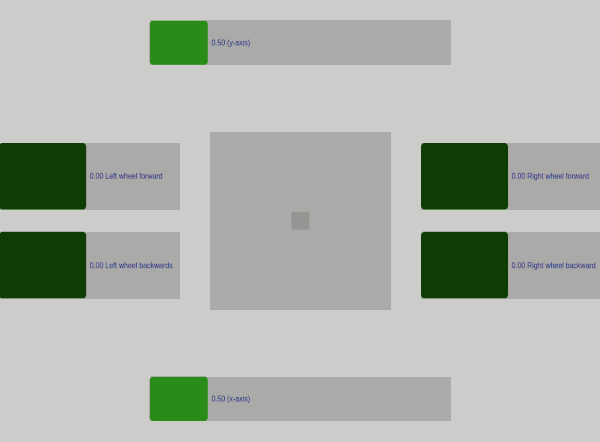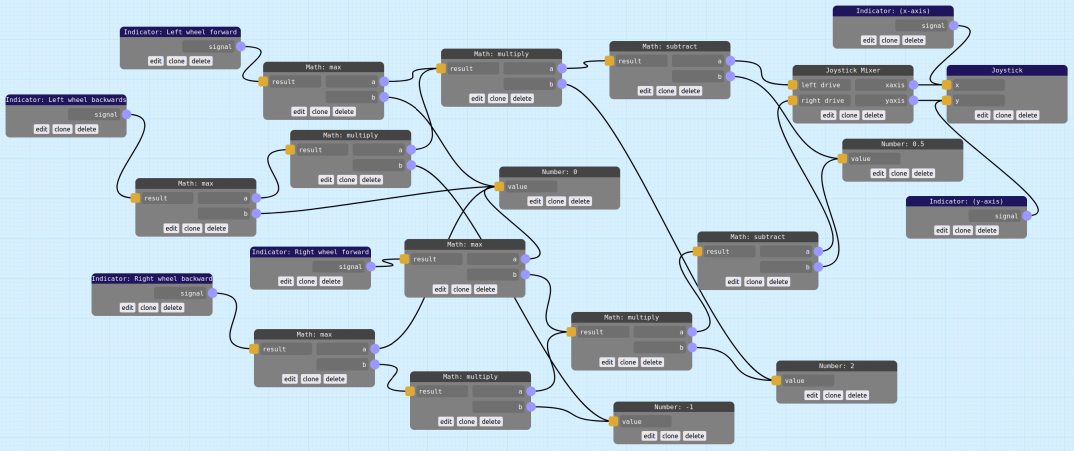Joystick Mixer Node: Difference between revisions
(Creates page.) |
(Adds big nodegraph) |
||
| (One intermediate revision by the same user not shown) | |||
| Line 12: | Line 12: | ||
Joystick Mixer Nodes were introduced in [[Firmware Releases|firmware version]] 2.1 along with all basic nodes. It has no configurable settings. | Joystick Mixer Nodes were introduced in [[Firmware Releases|firmware version]] 2.1 along with all basic nodes. It has no configurable settings. | ||
[[File:Joystick-mixer-example-controller.gif|center|thumb|764x764px|A demonstration controller built using a [[Joystick Node]], a Joystick Mixer Node and [[Indicator Node|Indicator Nodes]]. Notice how the x and y axis values from the joystick are transformed into forward/backward drive motor signals (here scaled and translated so that they range from -1 to 1, and then inverted on the "backwards" indicators so that they can be displayed using Indicator Nodes).]] | |||
==Inputs== | ==Inputs== | ||
| Line 18: | Line 19: | ||
==Outputs== | ==Outputs== | ||
Joystick Mixer Nodes have two output ports: '''left drive''' and '''right drive''' that reprsent the velocity of a left or right drive motor in a [[wikipedia:Differential_wheeled_robot|differential drive]] robot, from 0 to 1 where 0 is ''fully reverse'' and 1 is ''fully forward'' - just as should be used for [[IO Config Editor#IO Units|H-Bridge IO Unit]] input ports. | Joystick Mixer Nodes have two output ports: '''left drive''' and '''right drive''' that reprsent the velocity of a left or right drive motor in a [[wikipedia:Differential_wheeled_robot|differential drive]] robot, from 0 to 1 where 0 is ''fully reverse'' and 1 is ''fully forward'' - just as should be used for [[IO Config Editor#IO Units|H-Bridge IO Unit]] input ports. | ||
== Example Use == | |||
Below is shown is how you might use the Joystick Mixer Node in a nodegraph to drive ''M1'' and ''M2'' on a default RoboPad.<br>[[File:Basic-joystick-drive.png|frameless|1074x1074px]] | |||
Conversely, the example gif above was achieved using this nodegraph:<br>[[File:Joystick-mixer-demo-nodegraph.png|frameless|1074x1074px]] | |||
Latest revision as of 03:29, 6 March 2023
Inputs
|
Outputs
|
| Version Introduced 2.1 |
The Joystick Mixer Node is a single-purpose node that takes x and y axis signals, ostensibly from a Joystick Node and mixes them to generate left/right differential drive motor drive signals that can be passed to H-Bridge IO Units.
Joystick Mixer Nodes were introduced in firmware version 2.1 along with all basic nodes. It has no configurable settings.

Inputs
Joystick Mixer Nodes have two input ports: xaxis and yaxis, which - just as their counter parts in the Joystick Node's output ports - represent a position between (0, 0) and (1, 1) on a dual-axis joystick, where (0.5, 0.5) is the central position - the neutral position where no motion should occur.
Outputs
Joystick Mixer Nodes have two output ports: left drive and right drive that reprsent the velocity of a left or right drive motor in a differential drive robot, from 0 to 1 where 0 is fully reverse and 1 is fully forward - just as should be used for H-Bridge IO Unit input ports.
Example Use
Below is shown is how you might use the Joystick Mixer Node in a nodegraph to drive M1 and M2 on a default RoboPad.
Conversely, the example gif above was achieved using this nodegraph:

